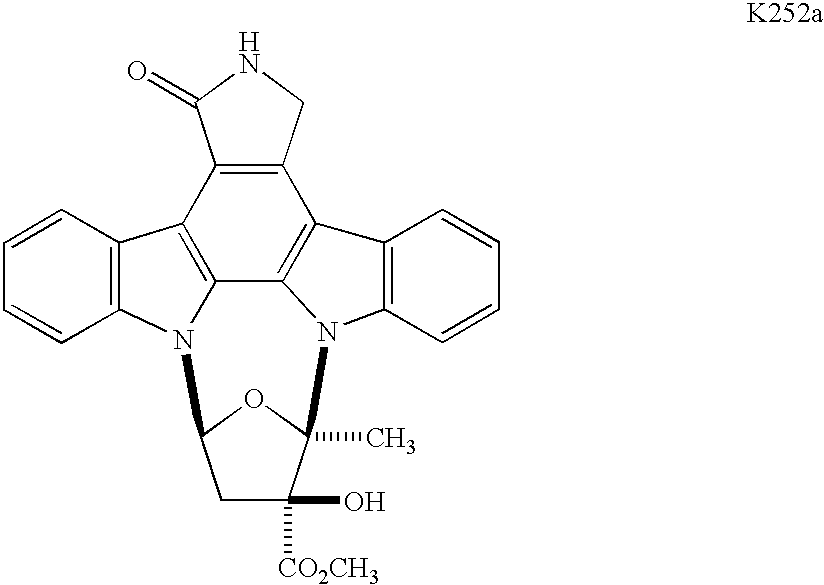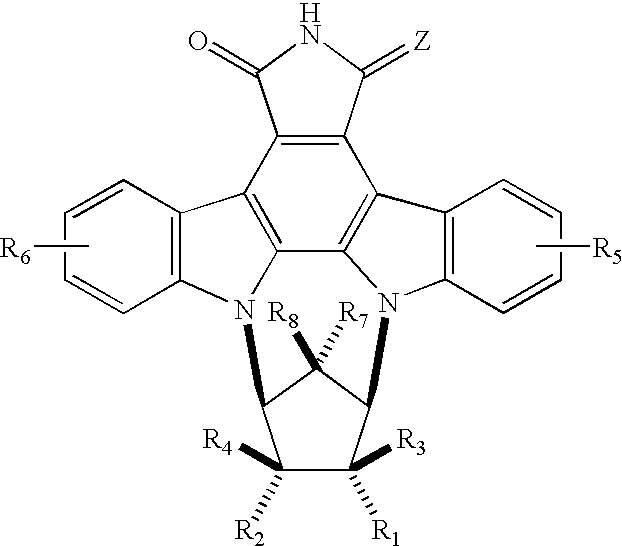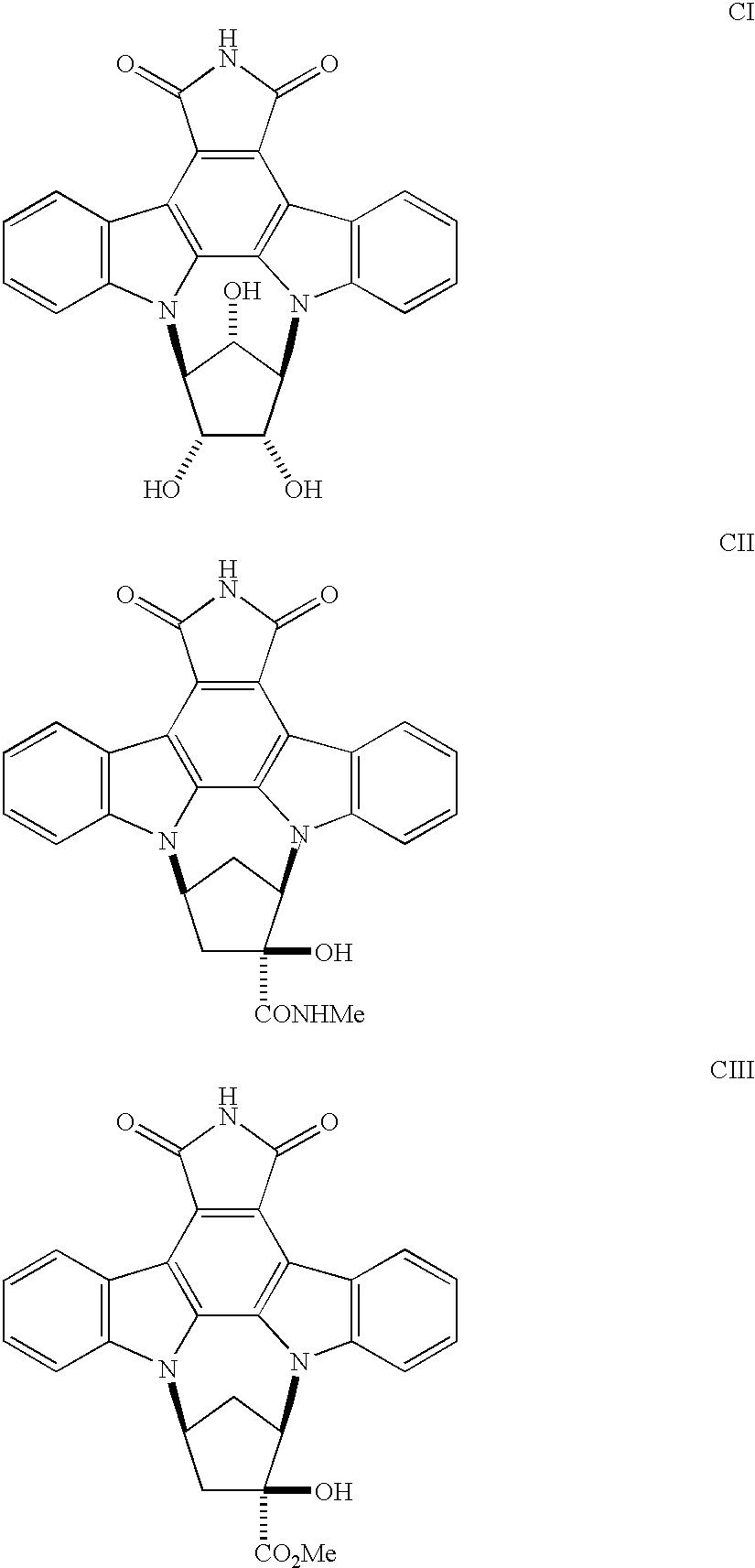Indolocarbazole derivatives useful for the treatment of neurodegenerative diseases and cancer
a technology of indolocarbazole and derivatives, applied in the field of indolocarbazole derivatives, can solve the problem of limiting the possibility of further modification
- Summary
- Abstract
- Description
- Claims
- Application Information
AI Technical Summary
Problems solved by technology
Method used
Image
Examples
example 1
Synthesis of 9,12-Methano-1H-diindolo[1,2,3-fg: 3',2',1'-kl]pyrrolo[3,4-][1,6]benzodiazocine-1,3 (2H)-dione,9,10,11,12-tetrahydro-10,11-dihydroxy-(9.alpha.,10.alpha.,11.alpha.,12.alpha.)
In order to develop more compounds having ERK2 inhibiting activity a series of synthetically modified derivatives of K252a were prepared. The preparation of four such compounds in which the preferential inhibition of PK40 over PKC / PKA was maintained by a margin of at least 2-3 orders of magnitude is described in Examples 1-4.
It is believed that these ATP analogs act as inhibitors of PK40(ERK2) by binding to the ATP binding site on PK40. PK40 seems to be particularly susceptible to inhibition by ATP analogs, resulting in similar selectivity to K252a and ATP itself. ##STR11##
Step 1. A solution of (1S,4R)-cis-4-acetoxy-2-cyclopentene-1-ol (53 mg, 0.37 mmol) and triethylamine (0.77 mL, 0.55 mmol) in a mixture of benzene (0.8 mL) and pentane (0.8 mL) was cooled to --5.degree. C.-0.degree. C. and treated w...
preparation of example 2
A solution of the imide from step 4 (14.4 mg, 0.04 mmol) and N-methylmorpholine (0.2 mL) in tetrahydrofuran (0.4 mL) was treated with osmium tetroxide (0.1 mL, 1.0 M in THF) and stirred at room temperature for one hour (until no starting material remained by TLC, EtOAc. The reaction mixture was quenched with NaHSO.sub.3 (1.5 mL, 2 M aqueous solution) and stirred vigorously for 1 hour. The solution was diluted with brine and extracted with EtOAc. The organic phase was dried over Na.sub.2 SO.sub.4 and concentrated in vacuo. The resulting yellow oil was purified by HPLC (0-3% MeOH-chloroform) to afford the target diol as a red-orange powder (9.5 mg, 61%). .sup.1 H NMR (DMSO-d.sub.6) .delta. 11.05 (s, 1H), 9.05 (s, 1H), 9.02 (s, 1H), 7.85 (s, 1H), 7.65 (m, 2H), 7.39 (m, 2H), 5.51 (m, 2H), 5.39 (m, 2H), 4.06 (s, 2H), 3.27 (m, 1H); 2.40 (m 1H). MS (FAB-LSIMS) m / z (relative intensity) 424 (M+H, 34), 381 (24), 362 (12), 310 (16), 185 (42), 121 (72), 93 (100), 55 (50); TLC: R.sub.f 0.2 (EtOA...
example 2
Synthesis of 9,12-Methano-1H-diindolo[1,2,3-fg: 3',2',1'-kl]pyrrolo[3,4-I][1,6]benzodiazocine-10-carboxylic acid, 2,3,9,10,11,12-hexahydro-10-hydroxy-1,3-dioxomethyl ester, (9.alpha.,10.beta.,12.alpha.).
##STR16##
Step 1. A solution of cyclopentene-3-ol [prepared using the protocols described in J. Org. Chem. 32, 1967, 4138] (2.1 g, 25.0 mmol) and triethylamine (3.60 mL, 25.8 mmol) in CH.sub.2 Cl.sub.2 (15.0 mL) was cooled to 0.degree. C. and treated with methanesulfonyl chloride (1.9 mL, 24.5 mmol) at a rate such that the temperature remained below 0.degree. C. After warming to room temperature and stirring for two hours, the reaction mixture was quenched with brine (40 mL) and extracted with CH.sub.2 Cl.sub.2 (90 mL). The organic extract was dried over Na.sub.2 SO.sub.4, filtered and concentrated in vacuo. Purification by MPLC (silica, 15-40% EtOAc-hexanes) gave the desired mesylate as a pale yellow liquid (3.74 g, 92%). .sup.1 H NMR (CDCl.sub.3) .delta. 5.74 (m 2H), 5.38 (m, 1H), 3...
PUM
| Property | Measurement | Unit |
|---|---|---|
| temperature | aaaaa | aaaaa |
| temperature | aaaaa | aaaaa |
| temperature | aaaaa | aaaaa |
Abstract
Description
Claims
Application Information
 Login to View More
Login to View More - R&D
- Intellectual Property
- Life Sciences
- Materials
- Tech Scout
- Unparalleled Data Quality
- Higher Quality Content
- 60% Fewer Hallucinations
Browse by: Latest US Patents, China's latest patents, Technical Efficacy Thesaurus, Application Domain, Technology Topic, Popular Technical Reports.
© 2025 PatSnap. All rights reserved.Legal|Privacy policy|Modern Slavery Act Transparency Statement|Sitemap|About US| Contact US: help@patsnap.com



